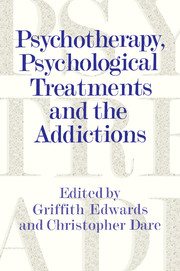Book contents
- Frontmatter
- Contents
- List of contributors
- Psychotherapy and psychological treatments of substance problems: generalism, specialism and the building of bridges
- Acknowledgements
- Part one Backgrounds to therapeutic understanding
- 1 Addictions over the life course: therapeutic implications
- 2 Psychotherapy and the life cycle: individual and family
- 3 Personal strengths and vulnerability in family and social context
- 4 Therapy in the eye of history: three episodes from the nineteenth century experience
- Part two Treatments
- Part three Postscript
- Index
1 - Addictions over the life course: therapeutic implications
from Part one - Backgrounds to therapeutic understanding
Published online by Cambridge University Press: 05 August 2016
- Frontmatter
- Contents
- List of contributors
- Psychotherapy and psychological treatments of substance problems: generalism, specialism and the building of bridges
- Acknowledgements
- Part one Backgrounds to therapeutic understanding
- 1 Addictions over the life course: therapeutic implications
- 2 Psychotherapy and the life cycle: individual and family
- 3 Personal strengths and vulnerability in family and social context
- 4 Therapy in the eye of history: three episodes from the nineteenth century experience
- Part two Treatments
- Part three Postscript
- Index
Summary
Introduction
Previous longitudinal studies (O'Donnnell, 1969; Maddox and Desmond, 1981; Vaillant, 1983; Edwards, 1984; Fillmore, 1988) have considered how alcohol and heroin abuse began, the factors that maintained these addictions, and how recovery is eventually achieved. Previous publications, but quite different ones, have addressed the issue of adult development (e.g. Vaillant, 1977, 1993). Indeed, over the past 25 years the monographs addressing adult development are far too many to cite.
What is missing, however, is a consideration of the relationship between adult development and substance abuse. In addressing this relationship and its therapeutic implications one must be tentative. Reliance must be placed on inadequate, parochial and sometimes speculative data. Often, even when the conclusions are empirically grounded, they will depend on data from a 50-year follow-up (Vaillant, 1983, 1995) of two relatively small cohorts of American men. Nevertheless, the relationship between substance abuse and adult development is important enough to examine with the data available. Only if and when the pioneering studies of adolescent drug use and abuse by Richard Jessor (1987) and Denise Kandel (1985) have survived for 50 years will we have an empirical basis with which really to address the questions posed in this chapter.
The greatest obstacle to understanding the relationship between adult development and the paths out of drug abuse is the impact of secular changes upon drug use. In many ways drug abuse is more like fashion - a result of historical whim - than a result of biology and thus susceptible to development forces. For example, it would be hard to tie women's choice of footwear to adult development. In the 1940s, young women wore plimsoles (the ancestors of running shoes) and the very old wore ‘granny’ boots. In the 1990s, the very old wear running shoes and young women wear ‘granny’ boots. In analogous fashion, in the late 1950s in Japan, there were up to 60 000 arrests a year for methamphetamine misuse; in the 1960s, when methamphetamine abuse was no longer in fashion, arrests for methamphetamine abuse sank to 200. By 1985, the number of methamphetamine arrests in Japan have again increased to 20 000 (Miller and Kozel, 1991). In other words, both onset and offset of methamphetamine abuse in Japan had more to do with the effects of historical fashion than with adult development or with therapy.
- Type
- Chapter
- Information
- Publisher: Cambridge University PressPrint publication year: 1996
- 2
- Cited by

